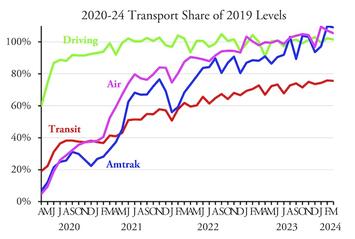
Americans drove almost 1.5 percent more miles in March of 2024 than in the March before the pandemic, according to data released yesterday by the Federal Highway Administration. Miles of driving have been at least 100 percent of 2019 numbers in six of the last eight months and at least 99 percent in 28 of the last 36 months.
Rural driving was 9.1 percent greater than in 2019 while urban driving was 1.8 percent less. The states with the biggest growth in driving are Indiana (33.8%), Montana (25.2%), Louisiana (23.0%), Arizona (17.0%), Idaho (16.6%), and Rhode Island (13.7%). The District of Columbia also saw 16.2 percent more driving in March 2024 than in 2019.
States where driving is still well short of 2019 levels include West Virginia (-28.6%), North Dakota (-19.2%), New York (-10.5%), Massachusetts (-10.2%), and California (-10.1%). Much of these differences is due to people moving from urban to rural areas or from some states to others.
Driving first reached 100 percent of pre-pandemic levels 29 months before transit reached 75 percent. This is due to the major differences in long-term impacts of the pandemic on transit vs. driving.
A new study published last week found that companies that attempt to get their remote-working employees to return to offices experience “an outflow of senior employees” to “firms that are direct competitors.” This poses “a potential threat to the productivity, innovation, and competitiveness of the wider firm.”
It is pretty clear that remote working has minimal effect on total driving, but it does have an effect on when people drive as people who work at home avoid rush-hour traffic. That means a reduction in congestion. However, remote working has a double effect on transit ridership, first because the downtown workers who were best served by transit are most likely to be working remotely and second because downtown workers who were taking transit to avoid congestion may now be driving to work due to the decreased traffic. This is why the effect of the pandemic on transit has been much more persistent than on other forms of travel.
This piece first appeared at The Antiplanner.
Randal O'Toole, the Antiplanner, is a policy analyst with nearly 50 years of experience reviewing transportation and land-use plans and the author of The Best-Laid Plans: How Government Planning Harms Your Quality of Life, Your Pocketbook, and Your Future.
Photo:chart courtesy of the Anitplanner.












